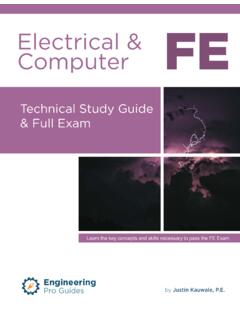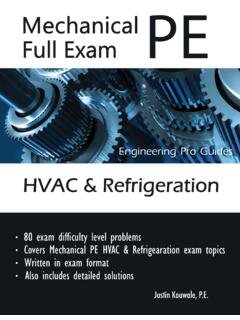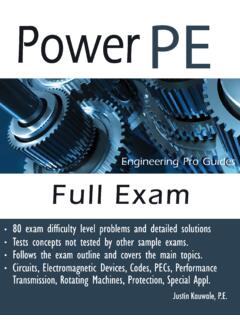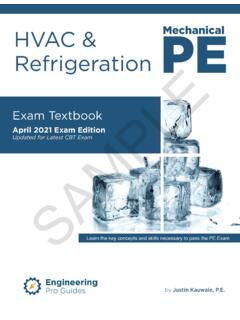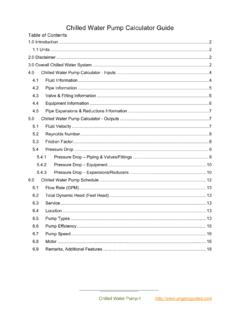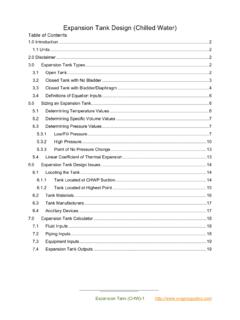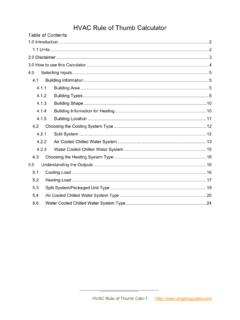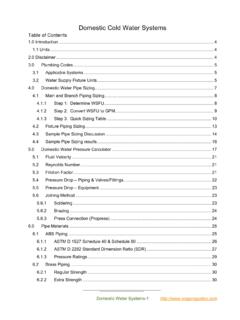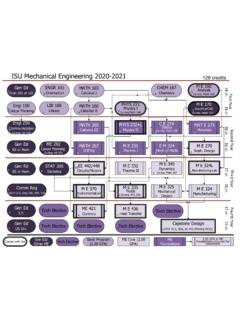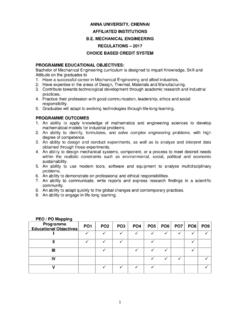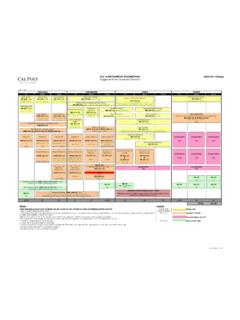Transcription of FEFE - Engineering Pro Guides - Mechanical and Electrical ...
1 FEFET echnical Study Guide &250+ Practice ProblemsUpdated for July 2020 Exam Learn the key concepts and skills necessary to pass the FE Examby Justin Kauwale, &Full Exam Mechanical FE Exam: Textbook & Full Exam by Justin Kauwale, PE Published by Engineering Pro Guides , LLC Honolulu, HI 96815 Copyright 2018-2020 Engineering Pro Guides , LLC All rights reserved. No part of this book may be reproduced in any form on by any means, electronic, Mechanical , photocopying, recording or otherwise, including information storage and retrieval systems, without permission in writing from the publisher, except as permitted by copyright law. 2020 Edition ISBN 978-1-7329987-3-5 (ebook) Copyright 2020 Engineering Pro Guides , LLC. Licensed for individual use only. Mechanical FE Textbook & Full Exam How to pass the Mechanical FE exam Table of Contents Section .. Introduction Section.
2 Mathematics Section .. Probability & Statistics Section .. Ethics & Professional Practice Section .. Engineering Economics Section .. Electricity & Magnetism Section .. Statics Section .. Dynamics, Kinematics and Vibrations Section .. Mechanics of Materials Section .. Material Properties & Processing Section .. Fluid Mechanics Section .. Thermodynamics Section .. Heat Transfer Section .. Measurement, Instrumentation and Controls Section .. Mechanical Design & Analysis Copyright 2020 Engineering Pro Guides , LLC. Licensed for individual use only. Copyright 2020 Engineering Pro Guides , LLC. Licensed for individual use only. 0 - Introduction How to Study for and Pass the FE Exam Study Guide Introduction - 1 Copyright 2020 Engineering Pro Guides , LLC. Licensed for individual use only. Section - Introduction Table of Contents Introduction.
3 2 Exam Format .. 2 Key Concepts and Skills .. 3 Units .. 7 Disclaimer .. 7 How to use this Book .. 7 Practice exam tips .. 8 NCEES FE Reference Handbook .. 11 Unit Conversion .. 11 Tables and Graphs .. 12 Past Exams .. 12 Pass Rates on Survey vs. NCEES .. 12 Estimated Cut Score .. 12 Introduction - 2 Copyright 2020 Engineering Pro Guides , LLC. Licensed for individual use only. INTRODUCTION One of the most important steps in an engineer's career is obtaining the professional Engineering ( ) license. It allows an individual to legally practice Engineering in the state of licensure. This credential can also help to obtain higher compensation and develop a credible reputation. The first step towards obtaining your is passing the Fundamentals of Engineering ( ) Exam. Both tests are administered by the National Council of Examiners for Engineering and Surveying (NCEES).
4 The FE Exam is a year round computer based test that can be taken as early as your senior year in college or with at least 3 years of Engineering -related work experience. Once passed, the FE Exam will certify you as an Engineering in Training (EIT). With enough experience after passing the EIT, you will become eligible for the PE Exam. Engineering Pro Guides focuses on helping engineers pass the NCEES exam through the use of free content on the website, and through the creation of books like sample exams and Guides that outline how to pass the PE exam. In the FE exam you will not be able to bring in any outside reference material. You will be given the NCEES FE Exam Reference Handbook, which contains all the necessary equations, tables, and graphs that you will need to solve each problem. The NCEES FE Exam Reference Handbook will be provided as a searchable electronic pdf during the test.
5 The key to passing the FE exam is understanding the key concepts and skills that are tested on the exam and becoming familiar with using this handbook to solve each problems in approximately 2-3 minutes. Although the NCEES handbook provides the necessary equations for the exam, knowing how to apply them and which equations to use requires an understanding of the concepts and practice of the skills. The FE Exam is available for 6 disciplines plus a generic Engineering discipline. This technical guide teaches you the key concepts and skills required to pass the Mechanical Exam in a single document. EXAM FORMAT How is the exam formatted? The FE exam format and additional exam day information can be found on the NCEES Examinee Guide ( ). The entire exam period is about 6 hours, with 2 minutes for signing agreements, 8 minutes for tutorials, and one break up to 25 minutes. You will have a total of 5 hours 20 minutes of actual exam time to solve 110 problems, which equates to about minutes per problem if spread out evenly.
6 The test is broken up into two sessions. The length of each session is determined by the number of problems, 55 problems per session, and not the time. So, you could spend more or less than half the time on the first session, and the remaining 5 hours 20 minutes will be allotted for the second session. Since the first session doesn t have a halfway time limit, it is very important to keep watch of the clock to make sure you have enough time for the second session. Before each session is completed, you are allowed to go back to problems that you may have skipped or want to check in that session. However, once the first session is completed and submitted, you are no longer allowed to revisit the questions in that session. There is a 25 minute break in between the sessions. You are allowed to take less than a 25 minute break or no break at all, but this does not increase the time you have to answer Introduction - 3 Copyright 2020 Engineering Pro Guides , LLC.
7 Licensed for individual use only. exam questions. No points are deducted for incorrect answers, so be sure to provide an answer for all questions, even if it is a guess. The final results are scaled based on the exam difficulty. There are five types of question formats that could be presented on the exam. 1. Multiple Choice (4 choices) Select one option, majority of questions in the exam 2. Multiple Answers Select multiple answers that are correct 3. Select by Clicking Click on a point on a graph, etc 4. Drag and Drop Matching, sorting, labeling, etc 5. Fill in the Blank Type in the answer The types of questions and number of questions per topic will be based on the outline provided by NCEES, discussed in the next section. These topics will not be labeled on the test. Finally, the NCEES Examinee Guide states that there will be some questions that will not be scored in the exam.
8 These are questions that are tested for their quality and possible use in future exams. Your final results will be given to you 7-10 days after you take the exam. KEY CONCEPTS AND SKILLS How are the key concepts and skills determined? The key concepts and skills tested in the sample exams and taught in this technical study guide were first developed through an analysis of the topics and information presented by NCEES. The above factors related to timing is considered. The Mechanical FE exam will focus on the following topics as indicated by NCEES. ( ): 1 Mathematics - (6-9 questions) i) Analytic Geometry ii) Calculus iii) Ordinary Differential Equations iv) Linear Algebra v) Numerical Methods vi) Algorithm and Logic Development 2 Probability and Statistics - (4-6 questions) i) Probability Distributions ii) Measures of Central Tendencies and Dispersions iii) Expected Value iv) Regression, Curve Fitting, Goodness of fit 3 Ethics and Professional Practice - (4-6 questions) i) Codes of Ethics ii) Public Health, Safety, and Welfare iii) Intellectual Property iv) Societal Considerations 4 Engineering Economics - (4-6 questions) i) Time Value of Money ii) Cost: incremental, average, sunk, estimating iii) Economic Analyses Introduction - 4 Copyright 2020 Engineering Pro Guides , LLC.
9 Licensed for individual use only. 5 Electricity and Magnetism (5-8 questions) i) Electrical Fundamentals ii) DC Circuit Analysis iii) AC Circuit Analysis iv) Motors and Generators 6 Statics (9-14 questions) i) Resultants of Force Systems ii) Concurrent Force Systems iii) Equilibrium of Rigid Bodies iv) Frames and Trusses v) Centroids and Moments of Inertia vi) Static friction 7 Dynamics, Kinematics, and Vibrations (10-15 questions) i) Kinematics of Particles ii) Kinetic Friction iii) Newton s Second Law for Particles iv) Work-Energy of Particles v) Impulse-Momentum of Particles vi) Kinematics of Rigid Bodies vii) Kinematics of Mechanisms viii) Newton s Second Law for Rigid Bodies ix) Work-Energy of Rigid Bodies x) Impulse-Momentum of Rigid Bodies xi) Free and Forced Vibrations 8 Mechanics of Materials (9-14 questions) i) Shear and Moment Diagrams ii) Stress Transformations and Mohr s Circle iii)
10 Stress and Strain caused by Axial Loads iv) Stress and Strain caused by Bending Loads v) Stress and Strain caused by Torsion vi) Stress and Strain caused by Shear vii) Stress and Strain caused by Temperature Changes viii) Combined Loading ix) Deformations x) Column Buckling xi) Statically Indeterminate Systems 9 Material Properties and Processing (7-11 questions) i) Properties: chemical, Electrical , Mechanical , physical, thermal ii) Stress-Strain Diagrams iii) Ferrous Metals iv) Nonferrous Metals v) Engineered Materials vi) Manufacturing Processes vii) Phase Diagrams, Phase Transformation, and Heat Treating viii) Materials Selection ix) Corrosion Mechanisms and Control Introduction - 5 Copyright 2020 Engineering Pro Guides , LLC. Licensed for individual use only. x) Failure Mechanisms 10 Fluid Mechanics (10-15 questions) i) Fluid Properties ii) Fluid Statics iii) Energy, Impulse, Momentum iv) Internal Flow v) External Flow vi) Compressible Flow vii) Power and Efficiency viii) Performance Curves ix) Scaling Laws for Fans, Pumps, and Compressors 11 Thermodynamics (10-15 questions) i) Properties of Ideal Gases and Pure Substances ii) Energy Transfers iii) Laws of Thermodynamics iv) Processes v) Performance of Components vi) Power Cycles vii) Refrigeration and Heat Pump Cycles viii) Non-reacting Mixtures of Gases ix) Psychrometrics x) Heating, Ventilation, and Air Conditioning (HVAC) processes xi) Combustion and Combustion Products 12 Heat Transfer (7-11 questions) i) Conduction ii) Convection iii) Radiation iv) Transient Processes v) Heat Exchangers 13 Measurement, Instrumentation, and Controls (5-8 questions) i) Sensors ii) Control Diagrams iii)
